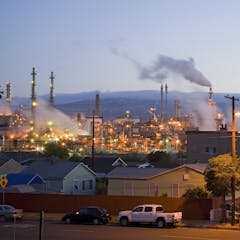
Articles on Environmental Protection Agency
Displaying all articles

Fossil fuel power plants can avoid most emissions by capturing carbon dioxide and pumping it underground. But to be a climate solution, that carbon has to stay stored for thousands of years.

Getting that detail right could mean the difference between a species surviving, or disappearing forever.

Poor communities of color have spent decades battling US industrial and agricultural pollution. A new EPA office is designed to support their struggle, but history suggests reason for caution.

HFCs keep refrigerators cool, but when these short-lived climate pollutants leak, they warm the planet.

Are health risks from air pollution less serious than we think? Mainstream scientists call this a fringe view, but it’s getting high-level attention at the Environmental Protection Agency.

The head of the World Health Organization calls air pollution ‘the new tobacco’ because it causes millions of preventable deaths yearly. Fine particle pollution is especially deadly.

According to one study, more than 8 million people per year die early from air pollution exposure.

Air pollution could be the next battleground between California and the Trump administration, which is reviewing the Golden State’s special legal authority to regulate tailpipe emissions.

Since the federal government started setting fuel economy standards, US-built cars have doubled their fuel efficiency, saving money for consumers and reducing pollution.

The fracking boom has led to a large increase of hydrocarbon emissions in rural areas, reversing some regional air toxics trends.

Cleaning up and reusing contaminated sites, known as brownfields, can create jobs and promote economic growth. But it also can drive gentrification that prices out low-income residents.

Economic forces – alongside a moral imperative – are driving cities, states and companies to make changes to forestall climate change, regardless of the whims of the White House.

President Trump’s budget would cut funding for Superfund, which cleans up the nation’s most toxic sites, by nearly one-third. An economist explains how Superfund cleanups benefit local communities.

Addressing social and health inequalities from pollution is no longer a priority at the EPA. What did the Office of Environmental Justice do and what will happen if it’s shut down?

The EPA served as a conduit between the federal government and at-risk communities. Communications scholars look at how environmental justice issues could be set back in scaled-down EPA.

Regulations that do significantly more harm than good are never appropriate, as the court concluded.

Greenhouse emissions from the aviation industry are still largely unregulated. The prospect of regulations for US flights sounds like progress, but it won’t happen without an elusive international consensus.

The EPA is seeking to clarify the reach of the landmark Clean Water Act to cover tributaries, yet people in agriculture and homeowners worry it will lead to onerous permitting.
